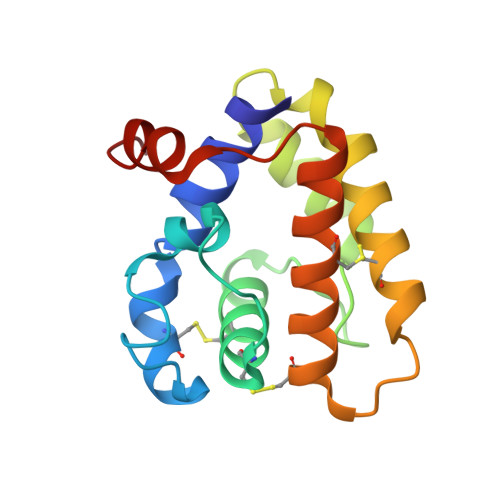Characterisation of Bombyx Mori Odorant-Binding Proteins Reveals that a General Odorant-Binding Protein Discriminates between Sex Pheromone Components.
Zhou, J.-J., Robertson, G., He, X., Dufour, S., Hooper, A.M., Pickett, J.A., Keep, N.H., Field, L.M.(2009) J Mol Biol 389: 529
- PubMed: 19371749
- DOI: https://doi.org/10.1016/j.jmb.2009.04.015
- Primary Citation of Related Structures:
2WC5, 2WC6, 2WCH, 2WCJ, 2WCK, 2WCL, 2WCM - PubMed Abstract:
In many insect species, odorant-binding proteins (OBPs) are thought to be responsible for the transport of pheromones and other semiochemicals across the sensillum lymph to the olfactory receptors (ORs) within the antennal sensilla. In the silkworm Bombyx mori, the OBPs are subdivided into three main subfamilies; pheromone-binding proteins (PBPs), general odorant-binding proteins (GOBPs) and antennal-binding proteins (ABPs). We used the MotifSearch algorithm to search for genes encoding putative OBPs in B. mori and found 13, many fewer than are found in the genomes of fruit flies and mosquitoes. The 13 genes include seven new ABP-like OBPs as well as the previously identified PBPs (three), GOBPs (two) and ABPx. Quantitative examination of transcript levels showed that BmorPBP1, BmorGOBP1, BmorGOBP2 and BmorABPx are expressed at very high levels in the antennae and so could be involved in olfaction. A new two-phase binding assay, along with other established assays, showed that BmorPBP1, BmorPBP2, BmorGOBP2 and BmorABPx all bind to the B. mori sex pheromone component (10E,12Z)-hexadecadien-1-ol (bombykol). BmorPBP1, BmorPBP2 and BmorABPx also bind the pheromone component (10E,12Z)-hexadecadienal (bombykal) equally well, whereas BmorGOBP2 can discriminate between bombykol and bombykal. X-ray structures show that when bombykol is bound to BmorGOBP2 it adopts a different conformation from that found when it binds to BmorPBP1. Binding to BmorGOBP2 involves hydrogen bonding to Arg110 rather than to Ser56 as found for BmorPBP1.
Organizational Affiliation:
Department of Biological Chemistry, Rothamsted Research, Harpenden, AL5 2JQ, UK. [email protected]















